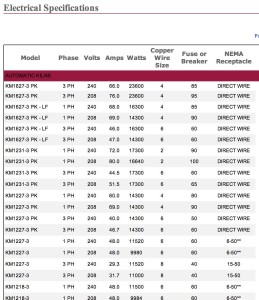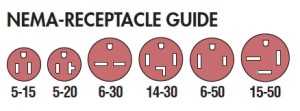 Many homes have a limited amount of power available to them. Adding more can be expensive and ordering the wrong kiln for your power supply can be a nightmare. All kiln manufactures will list the power requirements by model for all of their kilns. Here are the main factors to consider when choosing the power specifications for your kiln.
Many homes have a limited amount of power available to them. Adding more can be expensive and ordering the wrong kiln for your power supply can be a nightmare. All kiln manufactures will list the power requirements by model for all of their kilns. Here are the main factors to consider when choosing the power specifications for your kiln.
Voltage
Voltage refers to the type of electrical supply you have in your home. Most home have 2 different voltages available. 120 Volt supply refers to the standard outlets in your home. These are the one you plug your television and hair dryer into. This supply is convenient but it may not be enough to run the size kiln you want to the temperature you need. This supply will generally power the size kiln that would fit on a counter.
240v will allow for higher amperages which in turn will allow for larger kilns that can fire hotter than 120v kilns. This is what an electric range or clothes dryer would run on. If you are going to want a big kiln you are going to want 240 Volt supply. It is most likely that this is not readily available in your home. You will probably need to get an electrician to come in to wire the proper breaker, supply wire, and outlet for your new kiln. This is done all the time so it should not discourage you, just make sure you budget for it. Often times you can get a ballpark estimate right over the phone.
 In commercial settings you may want to have your voltage tested since 208 Volt supply is quite common. It is rare to find this voltage supply in your home.
In commercial settings you may want to have your voltage tested since 208 Volt supply is quite common. It is rare to find this voltage supply in your home.
Amperage
Amperage refers to the amount of electrical supply you have available in your home. Most newer homes have about 200 Amps available to them. Some older homes only have 100 Amps. If you know the Amperage available to your home, go look in your breaker box and add the amperage of all of your breakers. The total amperage available minus the total amperage of your existing breakers will give you a rough idea of how much amperage you have available for your new kiln. To be exact you would need to add the amp draw of every light bulb and appliance you would run while your kiln is running. Usually this is over kill but if you are concerned ask you electrician.
 Phase
Phase
Phase is one of those subjects we hate to bring up because it can be a little confusing. The only reason we bring it up is that it is one of the bits of information your salesperson is going to ask you when you order your kiln. Basically all you need to know if it is going in your house is that 99.9% of the time, you have a single phase power supply (1 PH). Commercial buildings often have 3 phase power supply (3 PH) available but it is very rare to find it in your home. A 3 PH plug will have 4 prongs, 3 phase wires (current carrying) and a ground. A 1 PH plug will have 3 prongs (2 phase wires and a ground). A 120V will have 3 prongs as well but one of the phase wires is replaced with a neutral wire which converts the 240V supply to 120V.

